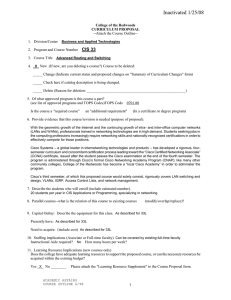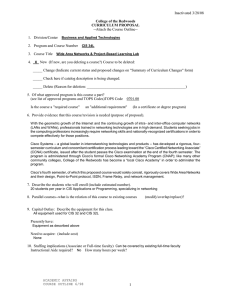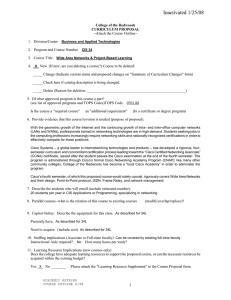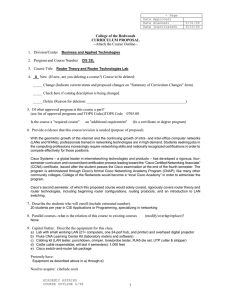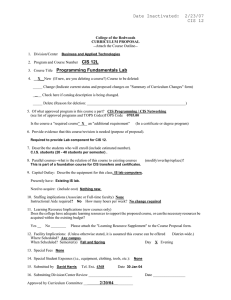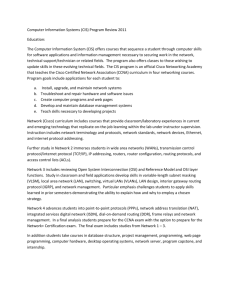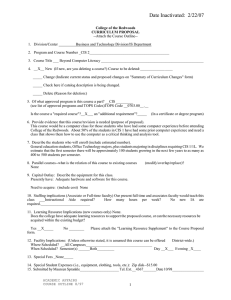Inactivated 3/28/08 --Attach the Course Outline-- 1. Division/Center
advertisement
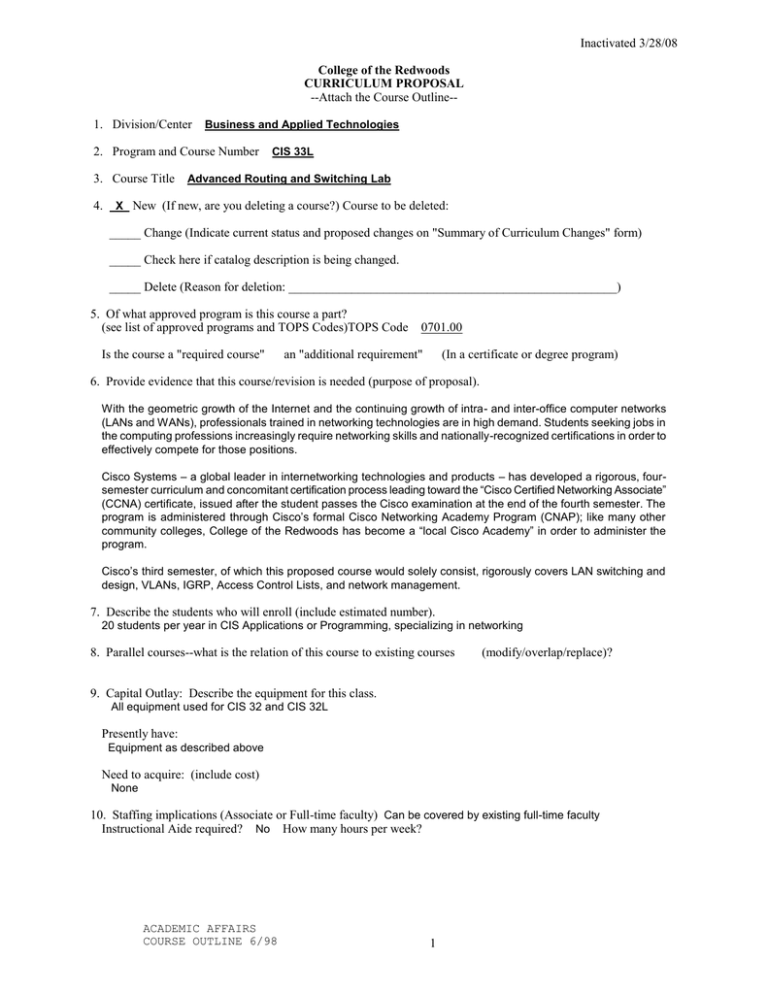
Inactivated 3/28/08 College of the Redwoods CURRICULUM PROPOSAL --Attach the Course Outline-1. Division/Center Business and Applied Technologies 2. Program and Course Number 3. Course Title 4. CIS 33L Advanced Routing and Switching Lab X New (If new, are you deleting a course?) Course to be deleted: _____ Change (Indicate current status and proposed changes on "Summary of Curriculum Changes" form) _____ Check here if catalog description is being changed. _____ Delete (Reason for deletion: ____________________________________________________) 5. Of what approved program is this course a part? (see list of approved programs and TOPS Codes)TOPS Code Is the course a "required course" 0701.00 an "additional requirement" (In a certificate or degree program) 6. Provide evidence that this course/revision is needed (purpose of proposal). With the geometric growth of the Internet and the continuing growth of intra- and inter-office computer networks (LANs and WANs), professionals trained in networking technologies are in high demand. Students seeking jobs in the computing professions increasingly require networking skills and nationally-recognized certifications in order to effectively compete for those positions. Cisco Systems – a global leader in internetworking technologies and products – has developed a rigorous, foursemester curriculum and concomitant certification process leading toward the “Cisco Certified Networking Associate” (CCNA) certificate, issued after the student passes the Cisco examination at the end of the fourth semester. The program is administered through Cisco’s formal Cisco Networking Academy Program (CNAP); like many other community colleges, College of the Redwoods has become a “local Cisco Academy” in order to administer the program. Cisco’s third semester, of which this proposed course would solely consist, rigorously covers LAN switching and design, VLANs, IGRP, Access Control Lists, and network management. 7. Describe the students who will enroll (include estimated number). 20 students per year in CIS Applications or Programming, specializing in networking 8. Parallel courses--what is the relation of this course to existing courses (modify/overlap/replace)? 9. Capital Outlay: Describe the equipment for this class. All equipment used for CIS 32 and CIS 32L Presently have: Equipment as described above Need to acquire: (include cost) None 10. Staffing implications (Associate or Full-time faculty) Can be covered by existing full-time faculty Instructional Aide required? No How many hours per week? ACADEMIC AFFAIRS COURSE OUTLINE 6/98 1 11. Learning Resource Implications (new courses only) Does the college have adequate learning resources to support the proposed course, or can the necessary resources be acquired within the existing budget? Yes X No ________ Please attach the "Learning Resource Supplement" to the Course Proposal form. 12. Facility Implications: (Unless otherwise stated, it is assumed this course can be offered District-wide.) Where Scheduled? When Scheduled? Semester(s) Fall and Spring Day Evening X 13. Special Fees None 14. Special Student Expenses (i.e., equipment, clothing, tools, etc.): 15. Submitted by Mark Renner Tel. Ext. 2340 None Date 29 Jan 01 16. Submitting Division/Center Review _______________________ Date _________________ 17. Division/Center Review ________________________________ Date _________________ 18. Division/Center Review ________________________________ Date _________________ Approved by Curriculum Committee __ ACADEMIC AFFAIRS COURSE OUTLINE 6/98 2/23/01 ________ 2 College of the Redwoods COURSE OUTLINE DATE 29 Jan 01 PROGRAM AND COURSE NUMBER: CIS 33L FORMER NUMBER (If previously offered) ______________ COURSE TITLE: ADVANCED ROUTING AND SWITCHING LAB I. CATALOG AND OUTLINE 1. CATALOG DESCRIPTION: Implementation of internetworking technology principles learned in CIS 33 using routers in a hands-on setting. NOTE: 2. COURSE OUTLINE: % of Classroom Hours Spent on Each Topic Common internetworking devices Configuring Routers Programming Routers for specific network setups Hands-On Network Design Hands-On Network Troubleshooting Case Study Research and Documentation 10% 25% 40% 10% 5% 10% II. PREREQUISITES Prerequisite? No ________ Corequisite? No ________ Recommended Preparation? No ___X____ Yes CIS 32L or equiv. (course) Yes CIS 33 (course) Yes __________________ (course) Rationale for Prerequisite, Corequisite, Recommended Preparation The lecture and lab components are tightly interwoven in the prescribed curriculum written by Cisco Systems. Concepts introduced in the lecture section, such as router configuration and programming, are reinforced in the lab section. The lecture and lab are separate courses only due to scheduling necessities. The prerequisite (CIS 32L) is the second in this four-part series, of which this course is the third part, and reinforces knowledge without which the student will not succeed (e.g., using the OSI Model; configuring and programming routers; LAN testing with software and meters). ACADEMIC AFFAIRS COURSE OUTLINE 6/98 3 PROGRAM AND COURSE NUMBER_CIS 33L III. OUTCOMES AND ASSESSMENTS 1. COURSE OUTCOMES/OBJECTIVES: List the primary instructional objectives of the class. Formulate some of them in terms of specific measurable student accomplishments, e.g., specific knowledge and/or skills to be attained as a result of completing this course. For degree-applicable courses, include objectives in the area of "critical thinking." Upon successful completion of this course, the students will be able to: Configure an internetworking router and associated hardware & software Program an internetworking router for IGRP and ACLs using IOS Create network designs Perform network management 2. COLLEGE LEVEL CRITICAL THINKING TASKS/ASSIGNMENTS: Degree applicable courses must include critical thinking tasks/assignments. This section need not be completed for non-credit courses. Describe how the course requires students to independently analyze, synthesize, explain, assess, anticipate and/or define problems, formulate and assess solutions, apply principles to new situations, etc. Analyze specific advanced LAN designs, technologies, and topologies Design, evaluate, and troubleshoot new and existing internetworks Apply knowledge of IGRP to the upgrade of a RIP network Demonstrate problem-solving and critical thinking skills via design and troubleshooting processes 3. ASSESSMENT Degree applicable courses must have a minimum of one response in category A, B, or C. If category A is not checked, the department must explain why substantial writing assignments are an inappropriate basis for at least part of the grade. A. This course requires a minimum of two substantial (500 words each) written assignments which demonstrate standard English usage (grammar, punctuation, and vocabulary) and proper paragraph and essay development. In grading these assignments, instructors shall use, whenever possible, the English Department’s rubric for grading the ENGL 150 exit essay. Substantial writing assignments, including: __ essay exam(s) __ term or other paper(s) ___ laboratory report(s) __ written homework __ reading report(s) __ other (specify) If the course is degree applicable, substantial writing assignments in this course are inappropriate because: __ The course is primarily computational in nature. X The course primarily involves skill demonstrations or problem solving. __ Other rationale (explain) __________________________________ B. Computational or Non-computational problem-solving demonstrations, including: __ exam(s) __ quizzes __ homework problems X laboratory report(s) __ field work X other (specify) laboratory journal C. Skill demonstrations, including: X_ class performance(s) __ field work __ other (specify) ______________________________________ X_ performance exam(s) D. Objective examinations, including: __ multiple choice __ true/false __ matching items __ completion __ other (specify) ________________________________________ E. Other (specify) Oral presentation NOTE: A course grade may not be based solely on attendance. ACADEMIC AFFAIRS COURSE OUTLINE 6/98 4 PROGRAM AND COURSE NUMBER CIS 33L IV. TEXTS AND MATERIALS APPROPRIATE TEXTS AND MATERIALS: (Indicate textbooks that may be required or recommended, including alternate texts that may be used.) Text(s) Title: CCNA Lab Companion, Vol. II (ISBN 1-58713-023-8) __X__ Required Edition:___1st___ ______ Alternate Author: ___Lorenz, Jim___ ______ Recommended Publisher:__Cisco Press__ Date Published: ___2000_________ (Additional required, alternate, or recommended texts should be listed on a separate sheet and attached.) For degree applicable courses the adopted texts have been certified to be college-level: ___X__ Yes. Basis for determination: ___X__ is used by two or more four-year colleges or universities (certified by the Division Dean or Center Dean) Partial list: CSU/Monterey Bay; CSU/Los Angeles; Cal Poly/San Luis Obispo OR ______ ______ No has been certified by the LAC as being of college level using the Coleman and Dale-Chall Readability Index Scale. Request for Exception Attached. REQUIRED READING, WRITING, AND OTHER OUTSIDE OF CLASS ASSIGNMENTS: Over an 18-week presentation of the course, 3 hours per week are required for each unit of credit. ALL Degree Applicable Credit classes must treat subject matter with a scope and intensity which require the student to study outside of class. Two hours of independent work done out of class are required for each hour of lecture. Lab and activity classes must also require some outside of class work. Outside of the regular class time the students in this class do the following: __X__ Study __X__ Answer questions __X__ Skill practice __X__ Required reading __X__ Problem solving activity or exercise _____ Written work (essays/compositions/report/analysis/research) __X__ Journal (reaction and evaluation of class, done on a continuing basis throughout the semester) _____ Observation of or participation in an activity related to course content (e.g., play, museum, concert, debate, meeting, etc.) _____ Other (specify) ______________________________________________________ ACADEMIC AFFAIRS COURSE OUTLINE 6/98 5 PROGRAM AND COURSE NUMBER CIS 33L V. TECHNICAL INFORMATION 1. Contact Hours Per Week: (Indicate "TOTAL" hours if less than semester length) Lecture: ______ Weekly ______ TOTAL Lab: ___3___ Weekly ______ TOTAL No. of Weeks ___S__ (S = semester length) (Use Request for Exception sheet to justify more-than-minimum required hours.) 5. Recommended Maximum Class Size _20_ Units 1.0 or Variable Unit Range ______ 7. Grading Standard _____Letter Grade Only __X___CR/NC Only ______Grade-CR/NC Option Grade-CR/NC Option Criteria: ______Introductory ______1st course in sequence ______Exploratory 6. Transferability___X__ CSU ______ UC List two UC/CSU campuses with similar courses (include course #s) CSU/Monterey Bay: CST 381 CSU/LA: TECH 490e Articulation with UC requested ______ 2. TLUs 3.0 3. Does course fulfill a General Education requirement? (For existing courses only; for new courses, use GE Application Form) _____ Yes __X__ No 8. Is course repeatable ______ Yes ___X__ No If so, repeatable to a maximum of: ______Total Enrollments ______Total Units (Use Request for Exception sheet to justify repeatability.) If yes, in what G.E. area? AA/AS Area _________ CSU/GE Area _________ IGETC Area _________ 9. SAM Classification ___C___ Course Classification ___I___ 4. Method of Instruction: _____ Lecture __X__ Lab _____ Lecture/Lab _____ Independent Study ACADEMIC AFFAIRS COURSE OUTLINE 6/98 6 Text(s) Title: CCNA Engineering Journal and Workbook, Vol. II (ISBN 1-57870-184-8) Edition:___1st___ Author: ___Amato, Vito___ Publisher:__Cisco Press__ Date Published: ___1999_________ ACADEMIC AFFAIRS COURSE OUTLINE 6/98 7 _____ _____ __X__ Required Alternate Recommended
